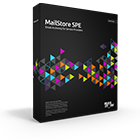MailStore Server to MailStore SPE Migration
This guide shows you, how to migrate a MailStore Server installation into the MailStore SPE.
This can be desired, if the customer has been using MailStore Server before, but now he wants the archive to be stored in a service provider's datacenter.
Also, when an on-premise mailserver or on-premise e-mail files, like PSTs, should be archived by an SPE instance, it might be a good decision to do the initial archiving with MailStore Server in the customer's infrastructure, and then migrating the resulting MailStore databases into the SPE. Since the MailStore databases usually are considerable smaller then the uncompressed e-mail volume, the amount of data to be transferred initially is significantly less. Usually a MailStore Server Trial license will do for that purpose.
The two products use a slightly different format of the MasterDatabase, which contains the configuration, therefore it is not possible to move the entire MailArchive directory of MailStore Server into the SPE. However, it is possible to transfer all the archive stores, which contain the actual messages.
- First you have to create an instance. The instance does not have to be started yet.
- Stop all archiving profiles in MailStore Server, either by setting the execution mode to manual or by disabling all scheduled tasks.
- Stop the MailStore Server service.
Important Notice: Do not start any of the archiving jobs on MailStore Server again, or else you might risk that some mails will not be archived by the new instance in the SPE.
- Copy the archive store directories from MailStore Server into the instance's Data directory. Do not transfer the MailStoreMaster.fdb and MailStore.xml files. Make sure, there is no remaining .lock file in one of the archive store directories. If there is any, the service is not stopped yet completely. When there are identical folder names, do not merge them, give them unique names before, instead.
- Start the SPE instance.
- Attach the transferred archive stores to the newly created instance.
- Depending on your setup:
- Create users or synchronize the instance with a directory service.
- Set compliance options.
- Check the rest of the configuration.
- Set up archiving profiles.
